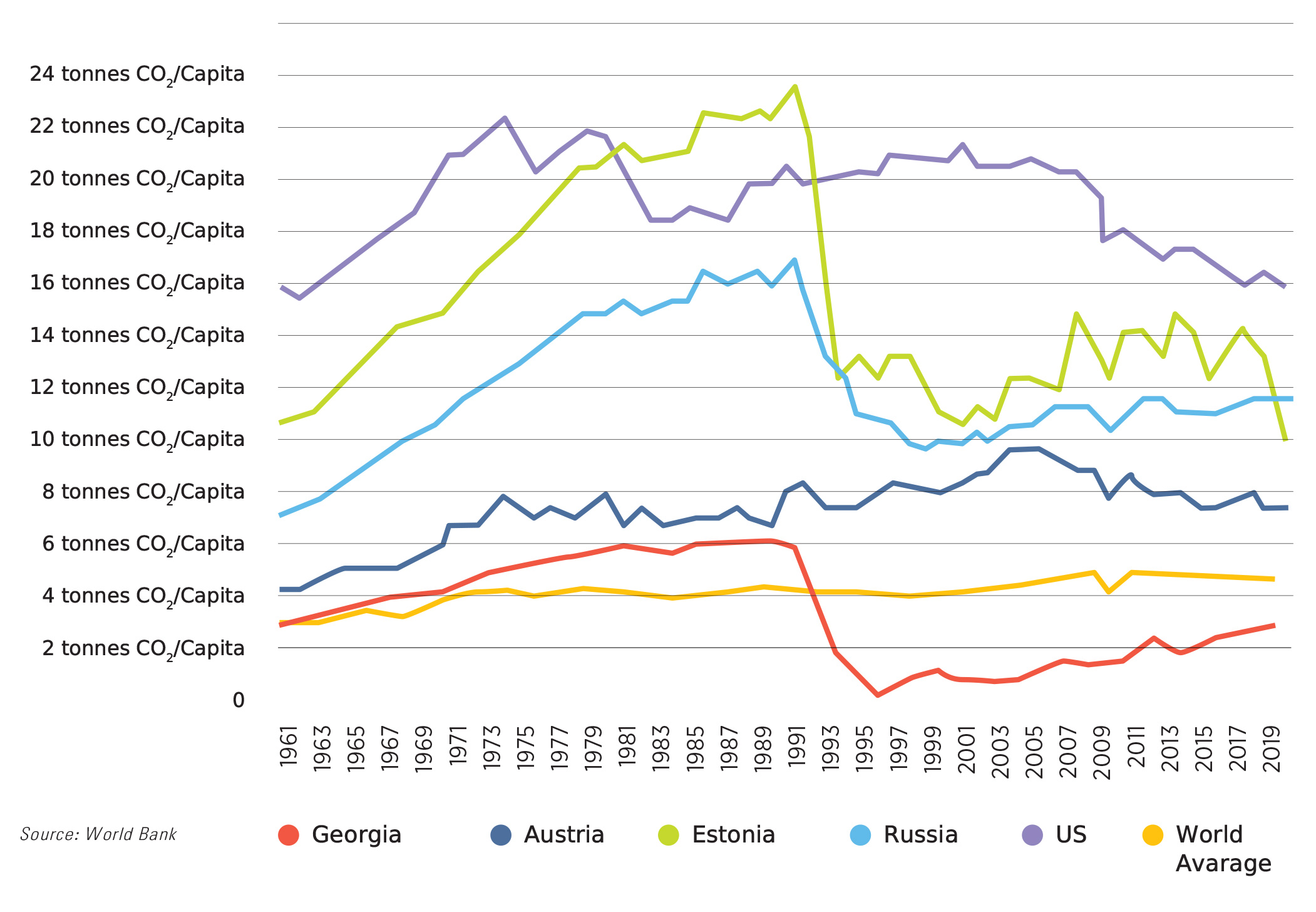According to the World Bank, the global economy emits up to 36.4 billion metric tons of carbon dioxide each year. These emissions are an almost invisible by-product of the modern economy. Together with natural CO2 emissions from fires, volcanos and marshlands, they accumulate in upper atmospheric layers, contributing to the greenhouse effect and exacerbating climate change. While it is difficult to quantify this effect and measure the pace of climate change, the decarbonization of the global economy is undoubtedly a top priority today.
The World Bank report identifies China as the main source of CO₂ emissions with 9.7 billion metric tons, followed by the United States with 4.71 billion tons and India with 2.4 billion tons.
The Georgian economy emitted 10 million tons of CO₂ in 2020, which is 0.03% of total global emissions. Against the background of the pandemic, emissions in Georgia fell by 0.5 million tons compared to 2019, representing a 5% decrease.
Carbon emissions are directly linked to industrial power. After the Soviet Union collapsed, pollution stopped coming out of Georgian factory chimneys. Some factories gradually resumed operation in the early 2000s, but carbon emissions in Georgia are still considerably lower than during the Soviet period. In 1990, the Georgian economy emitted 16 million tons of CO₂. As a result of the post-independence economic crisis, the country’s GDP decreased by two thirds within five years. This is reflected in the carbon emission statistics of the World Bank, which show a sevenfold decrease in CO₂ emissions (from 16 million tons to 2.3 million tons) in this period. The figures do not specify to what extent wood ovens and oil lamps contributed to these emissions. The Georgian economy began to grow again in the second half of the 1990s. Although some factories started to reopen in the 2000s, a return to the Soviet-era level of emissions is out of the question.
Georgia is by no means the only country to reduce its carbon emissions during the last thirty to forty years. Western Europe, the United States, Japan and other countries have also been successful in this regard. Conversely, countries with growing economies and growing populations have seen an increase in emissions.
CO₂ emissions in the United States peaked at 6.13 billion tons in 2007, before falling to 4.7 billion tons by 2020. Russia emitted 2.53 billion tons of CO₂ at its peak in 1990, while in 2020 its emissions totaled 1.6 billion tons.
In the case of China, emissions are growing fast and reaching record levels each year. This trend is expected to continue until 2050. Only then are emission levels in China likely to stabilize and begin to fall.
Georgia joined the Paris Agreement on climate change in 2015. The country committed itself to ensuring that by 2030, its emissions will be 35% lower than the 1990 figure. Under the current circumstances, achieving this target is entirely realistic.
Carbon Emissions per Capita

The World Bank also calculates per capita CO₂ emissions to give a balanced picture of emission figures. Based on these calculations, annual global emissions are 4.75 tons per capita. The figure for Georgia is 2.77 tons, which is below the global average. In comparison, Russia emits 11.6 tons of CO₂ per capita, the United States 16.1 tons, Austria 7.7 tons and Estonia 10.5 tons.
Numerous countries will struggle to meet their commitments in the Paris Agreement. For example, Germany committed to reducing greenhouse gas emissions by at least 40% by 2030 compared to 1990 levels. Germany emitted 1.1 billion metric tons of CO₂ in 1990, and 776 million tons in 2020.
CAPITALIZATION OF THE GREEN ECONOMY
Large corporations are working on reducing their own carbon footprint. This can be achieved in two ways: The first is to directly cut emissions from industrial processes or replace traditional energy consumption with green energy. The other way is carbon credit trading – an accounting method that allows a company to offset its carbon footprint by obtaining ‘carbon credits’ from companies that absorb emissions in exchange for payment. These credits can be obtained from companies involved in forestry or green energy production. There are different types of carbon credits that are equal to the price of one metric ton of carbon dioxide or the equivalent of other greenhouse gases.
Georgia only took part in carbon credit trading once – in 2015 – when the Enguri HPP sold 400,000 credits to the Norwegian Statkraft with the help of EBRD. This transaction allowed Statkraft to neutralize 400,000 tons of its greenhouse gas emissions. Since then, no Georgian company has participated in a deal of the same kind. One of the reasons for this is the existence of a technical barrier in the shape of the difficulty of recording the exact volume of absorbed emissions and conducting an audit in this field.

















